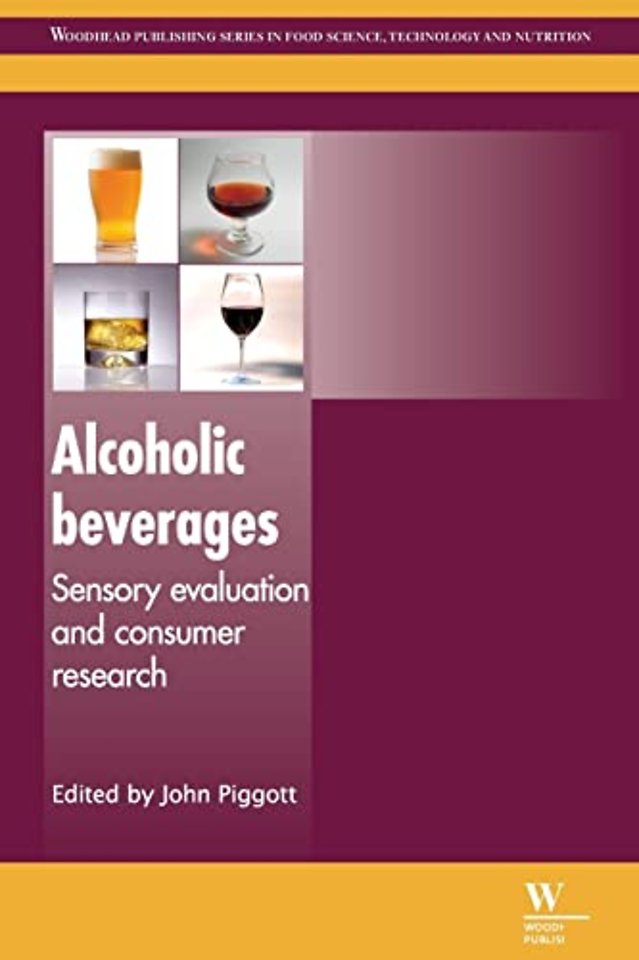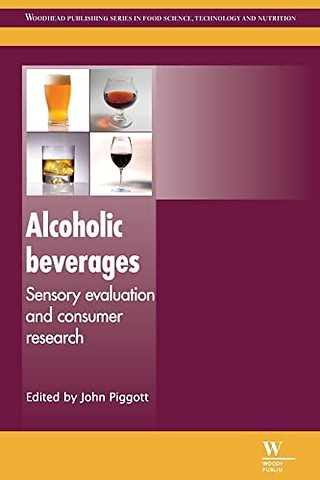<p>Contributor contact details</p> <p>Woodhead Publishing Series in Food Science, Technology and Nutrition</p> <p>Preface</p> <p>Part I: Sensory evaluation: principles and application to alcoholic beverages</p> <p>Chapter 1: Overview of sensory perception</p> <p>Abstract:</p> <p>1.1 Introduction</p> <p>1.2 The common senses</p> <p>1.3 Oro-sensory systems</p> <p>1.4 Sense of smell</p> <p>1.5 Integration of sensory information</p> <p>1.6 Mechanisms of perception, cognition and emotion</p> <p>1.7 Sensory perception, satiation and food reward</p> <p>1.8 Sensory perception and learning of preferences</p> <p>1.9 Conclusion and future trends</p> <p>Chapter 2: Sensory quality control and assurance of alcoholic beverages through sensory evaluation</p> <p>Abstract:</p> <p>2.1 Introduction</p> <p>2.2 Sensory quality concerns and issues in the alcohol beverage industry</p> <p>2.3 Similarities and differences in alcoholic beverages</p> <p>2.4 Factors influencing the development of off-flavors and taints</p> <p>2.5 The use of instrumental methods to aid sensory quality evaluations</p> <p>2.6 Future trends in quality evaluations</p> <p>2.7 Additional sources of information</p> <p>2.8 Conclusions</p> <p>Chapter 3: Principles of sensory shelf-life evaluation and its application to alcoholic beverages</p> <p>Abstract:</p> <p>3.1 Introduction: principles of sensory evaluation in shelf-life testing</p> <p>3.2 General principles of shelf-life estimation</p> <p>3.3 Microbial analysis</p> <p>3.4 Sensory discrimination tests</p> <p>3.5 Quantitative descriptive tests</p> <p>3.6 Sensory term reduction</p> <p>3.7 Sensory profile changes in alcoholic beverages</p> <p>3.8 Consumer acceptability testing</p> <p>3.9 Instrumental analysis</p> <p>3.10 Accelerated storage tests</p> <p>3.11 Future trends</p> <p>Chapter 4: Sensory methods for product development and their application in the alcoholic beverage industry</p> <p>Abstract:</p> <p>4.1 Introduction</p> <p>4.2 Perceptual maps</p> <p>4.3 Temporal dominance of sensation (TDS)</p> <p>4.4 Prediction of perceived astringency induced by phenolic compounds in alcoholic beverages</p> <p>4.5 Future trends</p> <p>Chapter 5: Gas chromatography-olfactometry of alcoholic beverages</p> <p>Abstract:</p> <p>5.1 Introduction</p> <p>5.2 Principles of gas chromatography-olfactometry (GC-O)</p> <p>5.3 Applications of GC-O in the flavour analysis of alcoholic beverages</p> <p>5.4 Conclusions</p> <p>Part II: Fermented products</p> <p>Chapter 6: Beer: production, sensory characteristics and sensory analysis</p> <p>Abstract:</p> <p>6.1 Introduction</p> <p>6.2 The origins of beer flavour</p> <p>6.3 Off-flavours and their origin</p> <p>6.4 Sensory analysis practice in the brewing industry</p> <p>6.5 Future trends</p> <p>Chapter 7: Fortified wines: styles, production and flavour chemistry</p> <p>Abstract:</p> <p>7.1 Introduction to fortified wines</p> <p>7.2 Comparison of styles and types of fortified wines and their production methods</p> <p>7.3 Flavour chemistry and sensory properties</p> <p>7.4 Legal aspects and health considerations</p> <p>7.5 Future trends</p> <p>Chapter 8: Sake: quality characteristics, flavour chemistry and sensory analysis</p> <p>Abstract:</p> <p>8.1 Introduction</p> <p>8.2 Quality of sake</p> <p>8.3 Flavour and aroma of sake</p> <p>8.4 Sensory evaluation method</p> <p>8.5 Future trends</p> <p>8.6 Sources of further information</p> <p>8.7 Acknowledgement</p> <p>Chapter 9: Table wines: sensory characteristics and sensory analysis</p> <p>Abstract:</p> <p>9.1 Introduction</p> <p>9.2 Categories of table wines</p> <p>9.3 Flavor chemistry and sensory aspects</p> <p>9.4 Sensory analysis applied to table wines</p> <p>9.5 Future trends</p> <p>Part III: Distilled products</p> <p>Chapter 10: Anise spirits: types, sensory properties and sensory analysis</p> <p>Abstract:</p> <p>10.1 Overview of anise spirits (pastis, ouzo, tsipouro)</p> <p>10.2 History of anise spirits</p> <p>10.3 Raw materials and production process</p> <p>10.4 Description of major variants</p> <p>10.5 Overview of flavour chemistry and sensory properties</p> <p>10.6 Description of sensory analysis practice in the anise spirit industry</p> <p>10.7 How consumer research is managed and executed</p> <p>10.8 Future trends</p> <p>Chapter 11: Cognac: production and aromatic characteristics</p> <p>Abstract:</p> <p>11.1 Raw materials, production process and major variants</p> <p>11.2 Overview of flavour chemistry and sensory properties</p> <p>11.3 Sensory analysis practice in the industry</p> <p>11.4 Consumer research: creation of the Cognac aroma wheel</p> <p>Chapter 12: Gin: production and sensory properties</p> <p>Abstract:</p> <p>12.1 Introduction</p> <p>12.2 Gin production</p> <p>12.3 Flavour chemistry</p> <p>12.4 Sensory properties of gin and sensory analysis practice in the industry</p> <p>12.5 Future trends</p> <p>Chapter 13: Grape-based brandies: production, sensory properties and sensory evaluation</p> <p>Abstract:</p> <p>13.1 Introduction</p> <p>13.2 Brandy production</p> <p>13.3 Types of brandies</p> <p>13.4 Understanding brandy flavour</p> <p>13.5 Sensory evaluation of brandy</p> <p>13.6 Brandy and consumer research</p> <p>13.7 Future trends</p> <p>Chapter 14: Grappa: production, sensory properties and market development</p> <p>Abstract:</p> <p>14.1 Introduction</p> <p>14.2 Production process</p> <p>14.3 Chemical composition and sensory properties</p> <p>14.4 Grappa categories</p> <p>14.5 Grappa tasting</p> <p>14.6 Grappa and the consumer</p> <p>14.7 New product development</p> <p>14.8 Future trends</p> <p>Chapter 15: Moutai (Maotai): production and sensory properties</p> <p>Abstract:</p> <p>15.1 Historical background</p> <p>15.2 Ecological environment</p> <p>15.3 Production of Kweichow Moutai</p> <p>15.4 Sensory properties and flavor chemistry</p> <p>15.5 Marketing</p> <p>15.7 Acknowledgements</p> <p>Chapter 16: Pisco: production, flavor chemistry, sensory analysis and product development</p> <p>Abstract:</p> <p>16.1 Introduction</p> <p>16.2 Pisco production</p> <p>16.3 Pisco flavor chemistry</p> <p>16.4 Main sensory properties of Pisco</p> <p>16.5 Sensory analysis practice in the Pisco industry</p> <p>16.6 Consumer research and product development in the Pisco industry</p> <p>16.7 Future trends</p> <p>16.8 Acknowledgments</p> <p>Chapter 17: Sugar cane spirits: cachaça and rum production and sensory properties</p> <p>Abstract:</p> <p>17.1 Introduction</p> <p>17.2 Raw materials</p> <p>17.3 Fermentation</p> <p>17.4 Distillation</p> <p>17.5 Maturation</p> <p>17.6 Cachaça and rum: similarities and differences</p> <p>17.7 Sensory quality of cachaça and rum</p> <p>17.8 The challenge of new markets</p> <p>17.10 Acknowledgement</p> <p>Chapter 18: Tequila and mezcal: sensory attributes and sensory evaluation</p> <p>Abstract:</p> <p>18.1 Introduction</p> <p>18.2 Origin of the sensory attributes of tequila and mezcal</p> <p>18.3 Sensory evaluation of tequila and mezcal from a research perspective</p> <p>18.4 Application of sensory evaluation in industry</p> <p>18.5 Sources of further information</p> <p>18.6 Acknowledgements</p> <p>Chapter 19: Whiskies: composition, sensory properties and sensory analysis</p> <p>Abstract:</p> <p>19.1 Introduction</p> <p>19.2 The influence of raw materials and production processes on sensory character</p> <p>19.3 Whisky composition and sensory properties</p> <p>19.4 Sensory analysis in the whisky industry</p> <p>19.5 Future trends</p> <p>Part IV: Consumer research methods: principles and application to alcoholic beverages</p> <p>Chapter 20: Consumer research in the wine industry: new applications of conjoint measurement</p> <p>Abstract:</p> <p>20.1 Background: understanding the mindset of the consumer</p> <p>20.2 Experiments and statistical tools</p> <p>20.3 Conjoint measurement (CM): experiments by mixing together ideas</p> <p>20.4 Applying CM to wine: traditional approaches</p> <p>20.5 Understanding white wine using experimental design of ideas</p> <p>20.6 The case of red wine</p> <p>20.7 Next generation thinking: price and emotion/feeling and its application to dessert wine</p> <p>20.8 Concluding remarks</p> <p>Chapter 21: Preference mapping: principles and potential applications to alcoholic beverages</p> <p>Abstract:</p> <p>21.1 Introduction</p> <p>21.2 Conducting central location trials (CLTs)</p> <p>21.3 Analyses</p> <p>21.4 Recent developments in preference mapping</p> <p>21.6 Acknowledgement</p> <p>Index</p>

